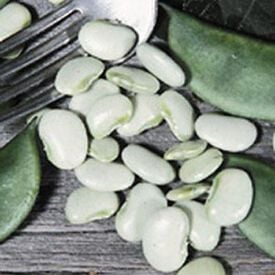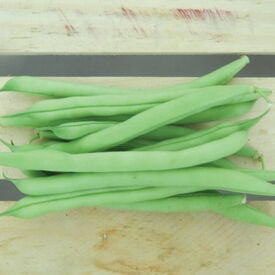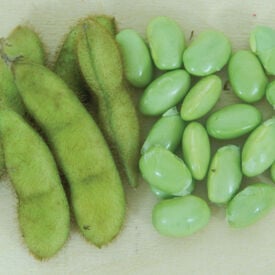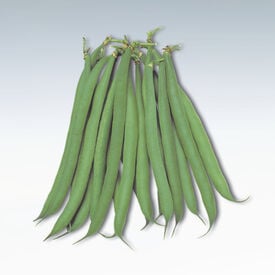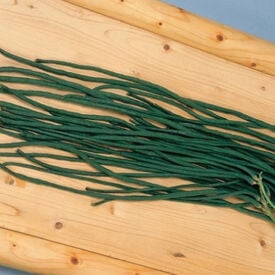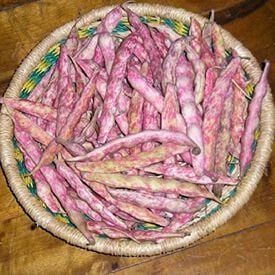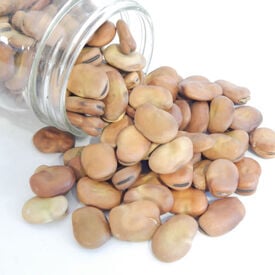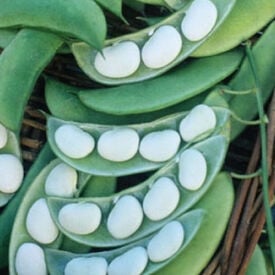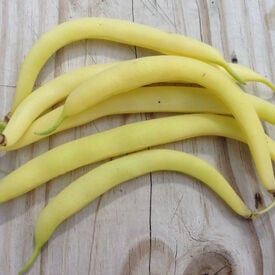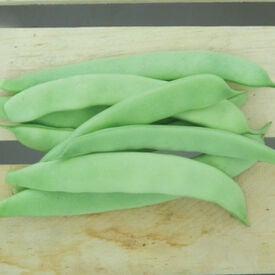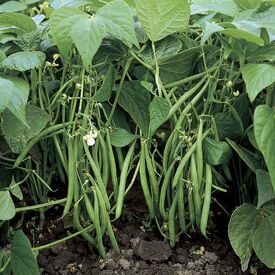Learn More
The Eastland bean, scientifically known as Phaseolus vulgaris 'Eastland,' is a popular variety of bush bean that hails from the United States. It is highly esteemed for its exceptional taste and ease of cultivation. Eastland beans belong to the family Fabaceae and are a warm-season crop commonly grown in gardens and small-scale farms. In terms of taste, Eastland beans are celebrated for their tender, crisp texture and rich, earthy flavor. They are a delight to eat both raw and cooked. The pods of Eastland beans are of medium size, typically measuring around 4-5 inches in length. The plants themselves are compact and bushy, making them suitable for smaller gardens and spaces. These beans have a relatively short maturity period, typically taking around 70-75 days from planting to harvest. The beans are known for their vibrant green color, making them visually appealing as well. Eastland beans are generally resistant to common bean diseases such as bean mosaic virus and rust. They are known to provide a good yield per acre, often ranging from 800 to 1,200 pounds of beans per acre, depending on growing conditions and care. Proper spacing is crucial for their growth, with plants typically spaced 3-4 inches apart in rows that are about 18-24 inches apart. These beans thrive in well-drained soil with full sun exposure and require regular watering to maintain consistent moisture levels in the soil. Overall, Eastland beans are a favorite among gardeners and farmers for their taste, disease resistance, and relatively quick harvest time.
The Provider bean is a stringless, fast maturing bush bean. Provider beans can be planted earlier than other beans because it germinates well in cool soils. Provider has compact bean plants that are easy to establish and adapt well to diverse soil and climate conditions. Harvest early for best stringless beans.
Envy is an early harvesting edamame for shorter growing seasons. Envy produces erect bush bean plants that reach about two feet in height and produce pods each containing two to three green seeds. Edamame is a popular snack in Japan, served with beer. Due to its health benefits that other snacks do not provide, it is becoming popular in the United States.
A gourmet, dwarf French filet bean well suited for container gardens or rows. Cooks appreciate the elegance of these petite, slim beans of consistent quality. Considered one of the best flavored beans that stay tender for several days after harvest. Suitable for small space gardens.
The Orient Wonder bean is a white seeded yard-long bean with tender pods. This type of pole bean is sometimes called asparagus or yard-long bean. Popular in warm and humid areas, where plants are vigorously vining. Extra-long, slender pods are slow to form seeds, resulting in more tender beans that can be harvested over an extended period. Orient Wonder is popular for specialty and ethnic markets and superior to standard strains due to its ability to set in cooler climates.
The French horticultural shell bean, also known as "Haricot Tarbais," is a classic heirloom variety renowned for its exceptional flavor and versatility in culinary applications. Originating in the Tarbes region of France, this bean has a rich historical significance in French cuisine. Its taste profile is a harmonious blend of nutty, earthy, and slightly sweet notes, making it a sought-after choice for gourmet dishes. This bean is classified as a pole bean, meaning it grows as a climbing vine that requires support. The pods of the French horticultural shell bean are medium-sized, typically reaching 4-6 inches in length, and they display a stunning mottled appearance with a creamy background and reddish streaks. The plant itself can attain a height of 8-10 feet, and it generally takes around 70-80 days to reach maturity from planting. In terms of disease resistance, the French horticultural shell bean exhibits decent resistance to common bean diseases like rust and mildew, although it's advisable to monitor and manage pests as needed. Under ideal growing conditions, this variety can yield approximately 1500-2000 pounds of beans per acre. Proper spacing is crucial for optimal growth; ensure that plants are spaced about 6-8 inches apart in rows that are 2-3 feet apart. These beans thrive in well-drained soil with full sun exposure and benefit from regular watering to maintain consistent moisture levels throughout the growing season. With its outstanding flavor and culinary versatility, the French horticultural shell bean is a delightful addition to any garden or kitchen.
The Broad Windsor fava bean, scientifically known as Vicia faba, is a prominent member of the legume family and has a rich history dating back thousands of years. Originating in the Mediterranean region and known for its versatility and unique taste, it has gained popularity worldwide. These beans are a type of broad bean, characterized by their large, flat, and slightly curved pods. The plant itself can reach a height of 3 to 4 feet and typically takes around 80 to 90 days to mature. In terms of appearance, Broad Windsor fava beans have large, broad pods that encase the beans. The pods are typically 6 to 8 inches long and are a vibrant green color. The beans themselves are quite large and have a distinctive earthy and nutty flavor, making them a favorite in various culinary dishes. When it comes to growing conditions, these beans thrive in cool weather and are often planted in early spring or late summer. They require well-drained soil and benefit from full sun exposure. Broad Windsor fava beans are known for their disease resistance, particularly against common bean diseases such as rust and aphids. On average, they can yield approximately 1,000 to 1,200 pounds per acre when properly cultivated with adequate spacing between plants, typically about 6 to 8 inches apart. Their versatility in both taste and growth conditions makes them a valuable addition to any garden or farm.
Our soup blend allows you to grow your own delicious bean soup. Our "Bean Soup" seed blend is equal blends of Vermont Cranberry Shell, Blackeye #5, Light Red Kidney, Dark Red Kidney, Pinto and Navy bean seeds. This combination creates a rich and creamy bean soup that is a delight to eat!
The Burpee Improved Bush Lime bean plants produce large pods, high yields, and perfectly shaped beans. Burpee Improved beans are both larger and thicker than normal lima beans. The growth is even more vigorous, with heavier foliage. The plants are uniformly upright.
Cherokee Wax beans, also known as Cherokee Yellow Wax beans, are a popular variety of bush beans cherished for their vibrant appearance and delicious flavor. These beans are believed to have originated from the Native American Cherokee tribe, hence their name. Cherokee Wax beans are a warm-season vegetable that thrives in various climates, making them a favorite among home gardeners and commercial growers alike. Cherokee Wax beans are known for their exceptional taste, boasting a mild, slightly sweet flavor with a tender and crisp texture. They are a type of bush bean, which means they grow as compact, bushy plants that don't require support structures. The pods of Cherokee Wax beans typically measure around 5 to 6 inches in length and have a bright yellow color. These beans have a relatively short time to maturity, usually taking about 50-55 days from planting to harvest. They are highly productive, yielding an impressive quantity of beans per 10-foot row. In terms of growing conditions, Cherokee Wax beans thrive in well-draining soil that receives full sun exposure. They require spacing of about 3-4 inches between plants and should be sown in rows that are 18-24 inches apart. Cherokee Wax beans are generally disease-resistant, with some varieties exhibiting resistance to common bean diseases like rust and mosaic virus. With proper care and regular harvesting, these beans can provide a bountiful and delicious addition to your garden or dinner table.
Roma II beans, also known as Romano beans or Italian flat beans, are a popular variety of green beans known for their exceptional flavor and unique appearance. These beans have a rich history dating back to ancient Rome, where they were cultivated and enjoyed for their culinary versatility. Roma II beans are distinct from traditional green beans due to their flat, wide pods and are favored by many for their tender, meaty texture and delicious taste. The taste of Roma II beans is often described as nutty and slightly sweeter than regular green beans, making them a sought-after choice in various culinary dishes. These beans are typically harvested when they are about 4-6 inches long, ensuring optimal tenderness and flavor. The plants of Roma II beans are known to be vigorous and can reach a height of about 18-24 inches. They have a relatively short maturity period, usually taking around 60 days to reach harvest readiness from the time of planting. The pods of Roma II beans are typically a vibrant green color and can grow to be 5-6 inches long. Roma II beans are prized for their resistance to common bean diseases, including common mosaic virus, rust, and bacterial brown spot, which can help ensure a healthy harvest. When properly cared for, these plants can yield a bountiful crop. For optimal growth, Roma II beans should be spaced about 3-4 inches apart in rows that are 18-24 inches apart. They thrive in well-drained soil and require full sun exposure, making them a great addition to any home garden or farm. Overall, Roma II beans are a delightful and versatile choice for those looking to grow and enjoy fresh, flavorful beans.
Jameson Bean is a popular and versatile variety of bean known for its exceptional taste and rich history. These beans are classified as a bush bean, which means they grow in a compact, bushy fashion without the need for support structures. Jameson Beans are typically small to medium-sized, oval-shaped, and boast a creamy texture with a slightly nutty and earthy flavor profile. They are a beloved choice for both fresh consumption and canning due to their outstanding taste. With a historical background dating back decades, Jameson Beans have been a favorite among home gardeners and commercial growers alike. They have a relatively short maturity period, typically taking around 50 to 55 days to reach full maturity from the time of planting. The beans themselves are often a vibrant green color, making them visually appealing in a variety of dishes. In terms of growing characteristics, Jameson Beans exhibit good disease resistance, particularly against common bean diseases such as rust and bean common mosaic virus. The yield per row can vary depending on factors such as soil quality and care, but they tend to be productive plants, providing a substantial harvest. It is recommended to space the plants about 2-4 inches apart in rows that are approximately 18-24 inches apart. These beans thrive in well-drained soil and require full sun for optimal growth, making them a reliable choice for both novice and experienced gardeners.
